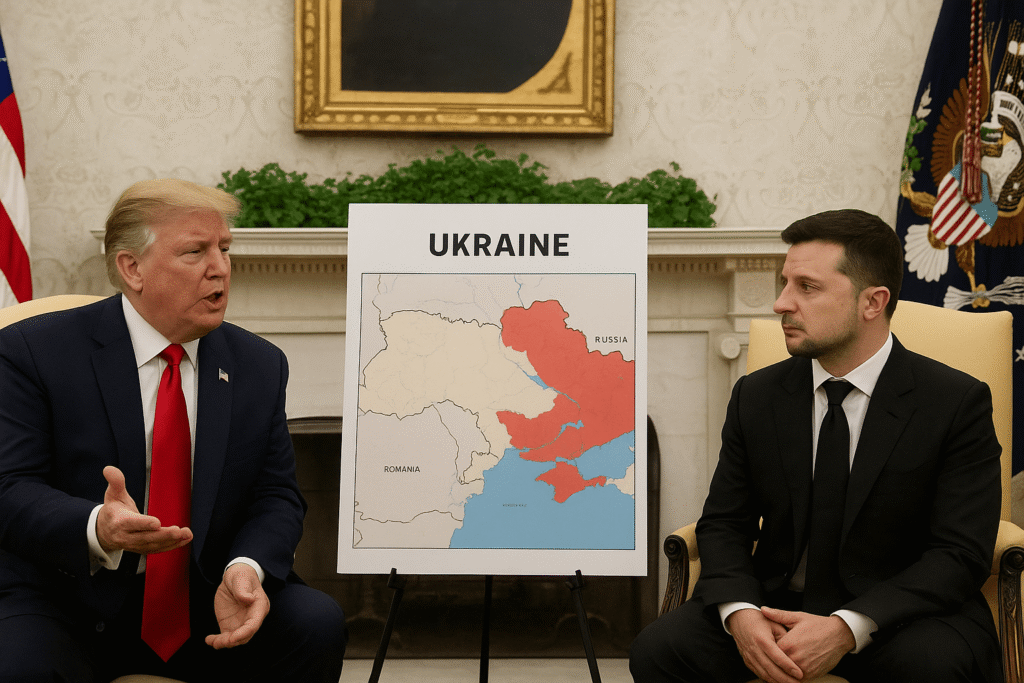A simple Ukraine war map has become a central symbol in one of the most high-stakes debates between former U.S. European leaders, Ukrainian President Volodymyr Zelensky, and President Donald Trump.Inside the Oval Office this week, the map dominated discussions about the ongoing Russia-Ukraine war and the prospects for a potential peace deal.
During Monday’s White House meeting, Trump displayed a map showing Ukraine’s territory, but with the eastern regions shaded red clearly marked as areas occupied by Russian forces since the 2022 full-scale invasion. For Trump, the visual message was unmistakable: large swathes of Ukraine were already under Moscow’s control, and Kyiv should consider a territorial compromise.
On Tuesday, Trump reinforced this message in a Fox News interview. He remarked, “I believe everyone saw the map. “A very large portion of Ukrainian territory has been taken.” His remarks underscored his belief that Ukraine’s battlefield position has weakened, making negotiations with Russian President Vladimir Putin inevitable.

Zelensky Pushes Back with His Own Map
Trump’s interpretation was contested by Ukrainian President Volodymyr Zelensky, who also brought a map to the Oval Office meeting. According to Zelensky, the two leaders debated “who controls what,” with each side pointing to different maps. “This is not a rumor, it’s reality,” Zelensky said afterward, describing the tense exchanges.
Zelensky argued that the Ukraine war map presented by Kyiv showed a very different reality. While Russia has occupied significant parts of Donbas, Zaporizhzhia, and Kherson, his team emphasized that Ukrainian forces still control major urban centers such as Kramatorsk and Sloviansk in Donetsk.
Crucially, Zelensky noted that over the last 1,000 days of fighting, Russia has managed to seize less than 1% of Ukraine’s overall territory, despite brutal offensives. According to the independent Ukrainian mapping group DeepStateUA, Moscow has captured roughly 5,842 square kilometers since November 2022 a far cry from the sweeping advances of the war’s early months.
Trump’s Position: A Territorial Deal with Russia
For Trump, however, the White House map was less about military precision and more about political messaging. His insistence that “Russia’s military strength is clearly much stronger” signaled his belief that Ukraine cannot sustain its defenses indefinitely. He suggested that negotiations over territorial concessions, particularly in the Donbas region, may be the only path to peace.
Reports circulating in Washington suggest Putin has privately communicated to Trump that Moscow intends to incorporate all of Donbas into a broader settlement. Such a deal would allow Russia to consolidate its control while conserving military resources after years of costly offensives.
European leaders present at the Oval Office meeting reportedly reacted uneasily to Trump’s suggestion of a territorial trade-off. The Donbas region rich in minerals and once contributing 16% of Ukraine’s GDP remains politically and symbolically vital to Kyiv. Local authorities stress that about 242,000 civilians still live in Ukrainian-held parts of Donetsk, making any handover unthinkable.
What the Maps Show
The White House map reportedly outlined Russian control over multiple Ukrainian regions:
- Luhansk: 99% under Russian control
- Donetsk: 76% under Russian control
- Zaporizhzhia: 73% under Russian control
- Kherson: 73% under Russian control
- Kharkiv: 4% under Russian control
- Sumy and Mykolaiv: 1% each under Russian control
Independent analysis by the Institute for the Study of War (ISW) broadly supports these figures, though minor discrepancies remain due to differences in measuring contested areas.
Still, Ukrainian officials stress that maps showing “1% control” often represent small Russian troop presences rather than meaningful territorial occupation. In regions like Sumy and Mykolaiv, Ukrainian forces have largely repelled Russian advances.
Russia’s Military Advances and Ukraine’s Struggles
Despite Ukraine’s resilience, experts warn of growing challenges. Russian advances have escalated in areas of eastern Ukraine, especially close to Kreminna in Luhansk and Kupiansk in Kharkiv, according to defense analyst Konrad Muzyka of Rochan Consulting.
“We’re seeing very heavy firepower, and the Ukrainians don’t have enough forces to contain it,” Muzyka said. He pointed to Ukraine’s manpower shortages and Russia’s increased use of drones to strike artillery, vehicles, and troop positions.
Moscow has also replenished its forces, reportedly recruiting between 30,000 to 35,000 new soldiers in recent months. While battlefield losses remain high, Russia has been able to build strategic reserves, giving it renewed offensive momentum.
Analysts warn that Russia still faces long-term challenges. Capturing the entirety of Donetsk, for example, could still take years of grinding warfare. Urban strongholds like Kramatorsk remain heavily fortified, making a swift victory unlikely.
Ukraine’s Fight for Survival
For Zelensky, the debate over maps is not just symbolic it’s about Ukraine’s survival as a sovereign nation. He insists that conceding territory to Russia would reward aggression and undermine international law. Kyiv continues to emphasize that every square kilometer of Ukrainian land matters, regardless of the percentage shown in U.S. or Russian assessments.
As both Trump and Zelensky double down on their conflicting narratives, the Ukraine war map has become a powerful tool in shaping perceptions of the conflict. For Washington policymakers, it now represents not just territorial lines, but competing visions of peace, sovereignty, and the cost of war.
